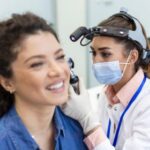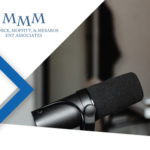Sleep Disorder Center in Central PA
Experienced Specialists Providing Treatment for Sleeping Disorders & Sleep Apnea
Forty-five percent of normal adults snore at least occasionally and twenty-five percent are habitual snorers. Problem snoring is more frequent in males and overweight people and usually worsens with age. Snoring may be an indication of obstructed breathing and should not be taken lightly. Melnick, Moffitt, and Mesaros ENT Associates can help you to determine where the anatomic source of your snoring may be, and offer solutions for this noisy and often embarrassing behavior.
If you are looking for an Ear, Nose, and Throat Doctor, please contact Melnick, Moffitt, and Mesaros ENT Associates for a comprehensive consultation.
The noisy sounds of snoring occur when there is an obstruction to the free flow of air through the passages at the back of the mouth and nose. This area is the collapsible part of the airway where the tongue and upper throat meet the soft palate and uvula. Snoring occurs when these structures strike each other and vibrate during breathing.
Socially – Snoring can make the snorer an object of ridicule and can cause the bed partner to experience sleepless nights and fatigue.
Medically – It disturbs sleeping patterns and deprives the snorer of adequate rest. It may be a sign of obstructive sleep apnea (OSA), which can lead to serious, long term health problems.
People who snore may suffer from
- Poor muscle tone in the tongue and throat: When muscles are too relaxed, the tongue falls backwards into the airway or the throat muscles draw in from the sides into the airway. Some relaxation is natural during deep sleep, but may become a problem if exacerbated by alcohol or drugs that cause sleepiness
- Excessive bulkiness of throat tissue: Children with large tonsils and adenoids often snore. Overweight people may have excess soft tissue in the neck that can lead to airway narrowing. Cysts or tumors are rare causes of airway narrowing.
- Long soft palate and/or uvula: A long palate narrows the opening from the nose into the throat. The excessive length of the soft palate and/or uvula acts as a noisy flutter valve during relaxed breathing.
- Obstructed nasal airways: A stuffy or blocked nose requires extra effort to pull air through it. This creates an exaggerated vacuum in the throat that pulls together the floppy tissues of the throat, and snoring results. So snoring may only occur during the hay fever season or with a cold or sinus infection. Also, deformities of the nose or nasal septum, such as a deviated septum (a deformity of the wall that separates one nostril from the other) can cause such an obstruction.
Snoring may be a sign of a more serious condition known as obstructive sleep apnea (OSA). OSA is characterized by multiple episodes of breathing pauses greater than 10 seconds at a time, due to the upper airway narrowing or collapsing. This results in lower amounts of oxygen in the blood, which causes the heart to work harder. It also causes disruption of the natural sleep cycle, which makes people feel poorly rested despite adequate time in bed. Apnea patients may experience 30 to 300 such events per night.
The immediate effect of sleep apnea is that the snorer must sleep lightly and keep the throat muscles tense in order to keep airflow to the lungs. Because the snorer does not get a good rest, he or she may be sleepy during the day, which impairs job performance and makes him or her a hazardous driver or equipment operator. Untreated obstructive sleep apnea increases the risk of developing heart attacks, strokes, diabetes, and many other medical problems.
Heavy snorers should seek medical advice to ensure that sleep apnea is not a problem. An otolaryngologist will provide a thorough examination of the nose, mouth, throat, palate, and neck, often using a fiberoptic scope. An examination can reveal if the snoring is caused by nasal allergy, infection, nasal obstruction, or enlargement of tonsils and adenoids
Snorers with any of the following symptoms should be evaluated for possible OSA:
- Endoscopic Sinus Surgery
- Balloon Sinuplasty
- Septoplasty
- Nasal and Facial Fracture Repair
- Turbinectomy
Treatment depends on the diagnosis and level(s) of upper airway narrowing. In some cases, more than one area may be involved. Treatment can be made with -
- A device that opens the airway with a small amount of positive pressure. This pressure is delivered via a nasal mask worn during sleep. This treatment is called CPAP; it is currently the initial treatment of choice for patients with OSA.
- Uvulopalatopharyngoplasty (UPPP) - This surgery removes excess soft palate tissue and opens the airway. In addition, the remaining tissue stiffens as it heals, thereby minimizing tissue vibration.
- Thermal ablation procedures reduce tissue bulk in the nasal turbinates, tongue base, and/or soft palate. These procedures are used for both snoring and OSA. Different methods of thermal ablation include bipolar cautery, laser, and radiofrequency. These procedures may be done in the operating room or during an office visit. Several treatments may be required.
- Methods to increase the stiffness of the soft palate without removing tissue include injecting an irritating substance that causes stiffness in the injected area near the uvula. Another method is inserting stiffening rods (Pillar implants) into the soft palate.
- Genioglossus and hyoid advancement is a surgical procedure for the treatment of sleep apnea. It prevents collapse of the lower throat and pulls the tongue muscles forward, thereby opening the obstructed airway.
- A custom-fit oral appliance, which repositions the lower jaw forward, may also be considered for certain patients with snoring/ OSA. This should be fitted by an otolaryngologist, dentist, or oral surgeon with expertise in sleep dentistry.
- In some patients, significant weight loss can also improve snoring and OSA.
There is no specific device recommended. More than 300 devices are registered in the U.S. Patent and Trademark Office as cures for snoring. Different methods include products that help a person avoid sleeping on their back, since snoring is often worse in that position. Some devices open nasal air passages; others have been designed to condition a person not to snore by producing unpleasant stimuli when snoring occurs. While a person may find a product that works for him or her, underlying poor sleep quality may remain.
- Adults who suffer from mild or occasional snoring should try the following self-help remedies:
- Adopt a healthy and athletic lifestyle to develop good muscle tone and lose weight.
- Avoid tranquilizers, sleeping pills, and antihistamines before bedtime.
- Avoid alcohol for at least four hours and heavy meals or snacks for three hours before retiring.
- Establish regular sleeping patterns.
- Sleep on your side rather than your back.
- Elevate the head of your bed four inches.
In children, snoring may be a sign of problems with the tonsils and adenoids. A chronically snoring child should be examined by an otolaryngologist, who may recommend a tonsillectomy and adenoidectomy to return the child to full health.
Poor muscle tone in the tongue and throat:
- Excessive bulkiness of throat tissue
- Long soft palate and/or uvula
- Obstructed nasal airways

“Really respect the doctors in this practice and truly appreciate Dr. Melnick. There is a serious lack of very good ENT doctors is our area, let alone ENTs in general, and yes, they can get busy and sometimes you wait a bit but I have never been rushed through my appointment and they have made sure I understand what is going to be done, what is going on etc. and have always been very patient and accommodating when problems arise. Frankly they are busy but I truly believe it’s more because this is a quality practice than anything and I would rather wait a bit if I have to in order to receive great care. I think it’s a small price to pay. I also talked to Dr. Melnick once about how busy they were and he told me that not only don’t they rush a patient through but because of the serious lack of doctors in their field, they try very hard to accommodate as many new patients as possible. I know this is rare as pulmonary doctors face the same problem in our area but I have yet to find one taking new non-emergent patients. My hat’s off to them for their ethics and commitment to the community.






